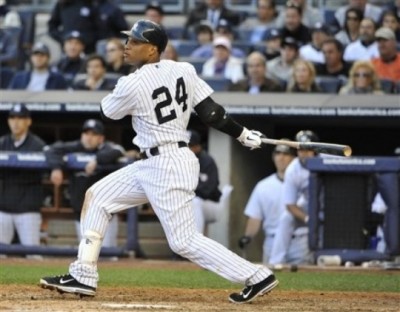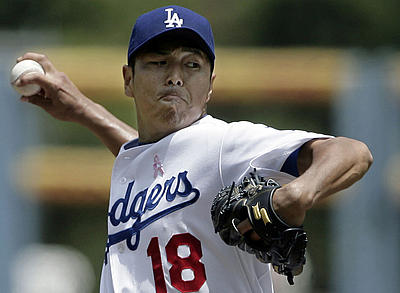Sounds so easy, don’t it? Just revolutionize a 40-year institution. Look, the bottom line is this: free agency is dying a slow death, anyway. Each year the class gets thinner and thinner because teams are locking up their young studs early and buying out their prime years so that the players that do eventually hit the market are all on the wrong side of 30 or middling, non-impact players, and usually both. The middling players are filler, and the occasional impact players on the wrong side of 30 are huge risks for most of the league to consider.
 Robinson Cano is a perfect example. He’s a top-three player in all of baseball and still in his prime, and his initial request of 10 years and $305 million will get his representatives laughed off the phone, but he’d likely end up signing something between teammates Mark Teixeira’s (8/180) and Alex Rodriguez’s (10/275) deals. I’d make a rough estimate at 8 years and $200 million dollars. Cano turns 31 next week and therefore would spend the bulk of the contract playing beyond age 34 than before it.
Robinson Cano is a perfect example. He’s a top-three player in all of baseball and still in his prime, and his initial request of 10 years and $305 million will get his representatives laughed off the phone, but he’d likely end up signing something between teammates Mark Teixeira’s (8/180) and Alex Rodriguez’s (10/275) deals. I’d make a rough estimate at 8 years and $200 million dollars. Cano turns 31 next week and therefore would spend the bulk of the contract playing beyond age 34 than before it.
It’s apparent that the Mets hierarchy is adverse to such risks, and I applaud them for it. It’s clear that most of baseball is as well, which is why this conundrum exists to begin with. The biggest deals are going to the younger stars entering their prime, not the ones leaving it. But there are holes to fill and some supreme talent available.
According to Baseball Reference (who makes educated estimates on arbitration costs; Cot’s does not), the Mets will pay out $54.8 million to their players under guaranteed contracts and eligible for arbitration, as well as bought-out options and deferred payments. This of course includes arbitration players such as Ike Davis, Lucas Duda, Greg Burke, Jordany Valdespin and other players whose return to the Mets is questionable. It’s safe to assume not everyone will return, so let’s round off committed payroll to $50 million for the sake of argument.
I don’t wish to get into a debate on just how much the Mets will spend over the winter. That’s not the point. The point is to come up with a way the Mets can sign free agents, but alleviate the overwhelming risks in doing so. Here’s the answer:
Overpay in money to keep the contract length shorter. Simple, right?
If Cano wants to have the highest AAV in baseball history, fine. Let him have it. Five years, $150 million. I’d even give him $175 million for five years. Is it that asinine? If he would get $25 million a year in a “normal” contract, wouldn’t you rather pay him an extra $5-$10 million a year to NOT have to pay him $25-$50 million over those final three least productive years? You could sell him on the idea that he’d get his $30 million a year and allay his issues with “pay cut” by pointing out he could still sign another contract at age 36. Signing Cano wouldn’t pigeon-hole the Mets into looking for a power bat from the left side in the outfield, because he would be their lefty power bat and allow them to simply find an outfielder, not necessarily an impact outfielder. He would also allow the Mets to shop Daniel Murphy in a package to bring back something to fill another hole.
 And they should do the same with Hiroki Kuroda, in my opinion the best free agent starting pitcher available. It’s been widely speculated that Kuroda will play for either the Yankees or the Dodgers, or go back to Japan. He made $15 million pitching in New York in 2013, so why not offer him $20 million to do the same in 2014. Kuroda might possibly be the best free agent fit for the Mets (with apologies to Cano and Shin-Soo Choo) because he would only sign for one year, which is exactly the length of time it would take Matt Harvey to return. He would also be the veteran presence the young pitching staff needs.
And they should do the same with Hiroki Kuroda, in my opinion the best free agent starting pitcher available. It’s been widely speculated that Kuroda will play for either the Yankees or the Dodgers, or go back to Japan. He made $15 million pitching in New York in 2013, so why not offer him $20 million to do the same in 2014. Kuroda might possibly be the best free agent fit for the Mets (with apologies to Cano and Shin-Soo Choo) because he would only sign for one year, which is exactly the length of time it would take Matt Harvey to return. He would also be the veteran presence the young pitching staff needs.
While that wouldn’t be a sacrifice at all for Kuroda, who wouldn’t have to move and get a handsome raise for not doing so, would Cano make that sacrifice? He has every right to look for every last cent he can get, and if he chooses not to leave $25-$50 million on the table and try for the longest, richest contract he can get, then good luck to him. But achieving his desire to have the highest AAV in MLB history and still signing another contract at age 36 to make up for the money he “lost” in the deal are inherent positives in taking that hypothetical deal from the Mets.
Suppose this all comes to fruition. That leaves the Mets with a manageable $100 million payroll. To put that in perspective, it would have ranked the Mets 15th in baseball if they sported that payroll in 2013 and would only be roughly $9 million more than their actual payroll. It’s likely Cano wouldn’t take that deal. It’s even less likely the Mets would spend $100 million in 2014. But it would get the Mets the best hitter and best pitcher available, fill a few holes, do it for a reasonable total payroll cost, and send one hell of a shockwave through Major League Baseball.














